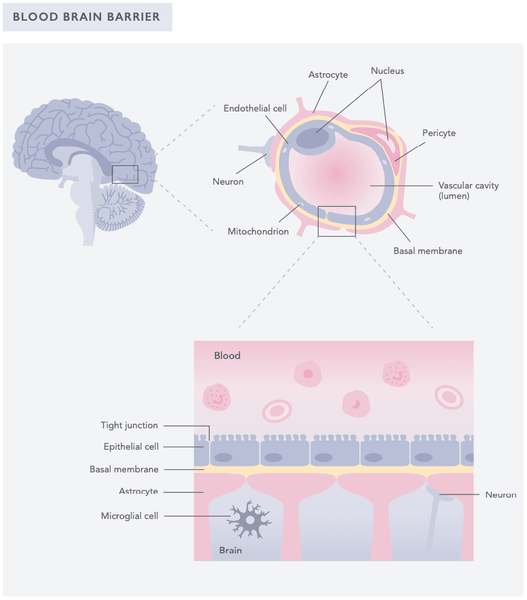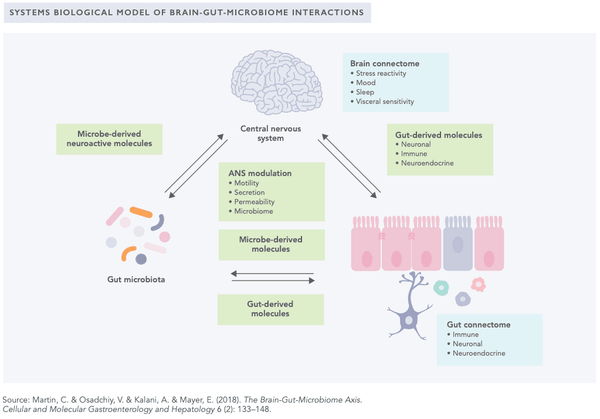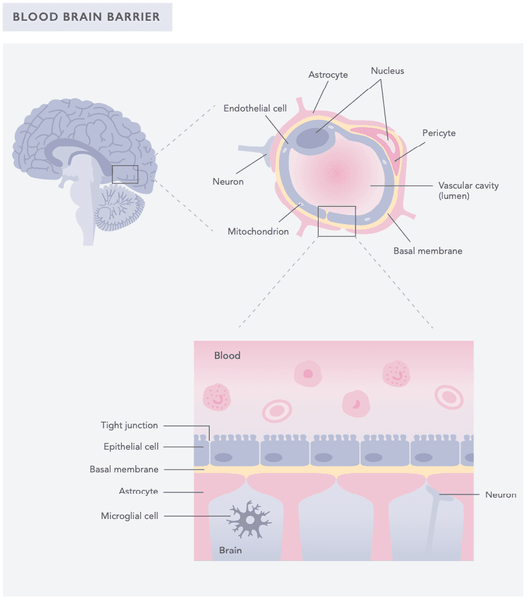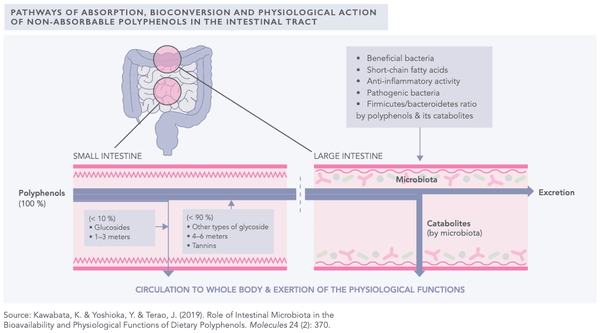Onko suolisto todella toiset aivomme? Mikä on suolen ja aivojen akseli? Miten suoliston terveyden parantaminen parantaa aivojen terveyttä ja toimintaa? Tässä artikkelissa kerrotaan kaikesta probiooteista, prebiooteista, suoliston ravintolisistä, ruokavaliosta ja paljon muusta. Lue eteenpäin!
Johdanto
Suoli-aivo-akselilla tarkoitetaan suolen hermoston (enteerinen hermosto) ja keskushermoston (aivot ja selkäydin) välistä yhteyttä. Suoliston terveyden ja aivojen toiminnan välillä on todellakin suora neurologinen ja biokemiallinen yhteys. Joskus suolistoa kutsutaan jopa "toisiksi aivoiksi". Suoliston mikrobiota (bakteerikanta) vaikuttaa immuunijärjestelmän toimintaan, hermoston toimintaan, käyttäytymiseen , stressinsietokykyyn , mielialaan ja mielenterveyteen . Viime aikoina on alettu ymmärtää, kuinka tärkeää suoliston terveys on aivojen hyvinvoinnille.
Yhdessä tutkimuksessa tutkijat vertasivat mikrobiotan vaikutuksia kognitiiviseen toimintaan. Tutkijat siirsivät ensin kaksi erilaista ulostenäytettä ihmisistä hiirten suolistoihin. Yksi ryhmä hiiriä sai ulostetta skitsofreniaa sairastavilta ihmisiltä ja toinen ryhmä henkisesti vakaalta ja yleisesti terveeltä ihmisryhmältä. Tämän seurauksena hiirille, jotka saivat siirteen skitsofreniapotilailta, kehittyi yliaktiivisuuden oireita ja he kamppailivat kognitiivisten tehtävien kanssa. Toisella ryhmällä, joka sai ulostetta terveiltä ihmisiltä, oli normaali kognitiivinen toiminta ja mieliala.
Tärkeää on, että tutkijat huomasivat, että hiirillä oli siirron jälkeen eri tasot tärkeitä aivohormoneja, kuten glutamaattia, glutamiinia ja GABA:ta – erityisesti hippokampuksessa. Tämä sai tutkijat päättelemään, että erot (siirretyn) suoliston mikrobiotassa moduloivat näiden hiirten aivohormonien tasoa, mikä puolestaan muutti heidän käyttäytymistään.
Suoliston terveys liittyy myös aivojen kasvuun ja neuroplastisuuteen. Esimerkiksi krooninen suolistotulehdus liittyy aivohormonien epätasapainoon ja aivojen kasvutekijän alhaisempiin tasoihin , kun taas terve suolisto edistää parempaa mielialaa, vakaata energiatasoa ja parempaa kognitiivista suorituskykyä.
Alabaman yliopiston tutkijat tekivät mahdollisesti uraauurtavan löydön aivoista vuonna 2018. Alustavan tutkimuksensa mukaan he havaitsivat, että aivoissa on eläviä bakteereja . Suurin osa bakteereista oli kolmesta suolelle yhteisestä fylasta: Firmicutes , Proteobacteria ja Bacteroidetes . Tämä havainto on vielä toistettava tieteellisesti ja tarkistettava lisätutkimuksilla.

Suoliston mikrobiota tarkoittaa mikrobien kokoelmaa, joka elää suolistossa (suolessa). Näitä ovat bakteerit, sienet ja virukset, joista osa on yhteydessä parempaan terveyteen ja osa sairauksiin (niin sanotut "hyvät" ja "huonot" mikrobit, vastaavasti). Suolistossa on noin 10 biljoonaa mikrobia. Mikrobiootan koostumus on ainutlaatuinen ja yksilöllinen – näin ollen se on kuin sormenjälki suolistossa.
Mikrobiyhteisö, mukaan lukien hyödylliset bakteerit, tukee terveyttä elämällä keskinäisessä synergiassa isäntäorganismin kanssa. Mikrobiota auttaa vahvistamaan suoliston pintaa, metaboloimaan ruoasta saatavaa energiaa, suojaamaan kehoa haitallisilta bakteereilta ja käsittelemään sappihappoja. Tärkeää on, että suoliston mikrobiotalla on vahvat yhteydet aivojen toimintaan. Tasapainoinen mikrobiota on yhteydessä parempaan kognitioon ja parempaan yleisterveyteen. Esimerkiksi 95 % välittäjäaineesta serotoniinista (tärkeä muistin, mielialan ja yhteistyökäyttäytymisen kannalta) tuotetaan suolistossa. Tästä syystä suolisto-ongelmat, kuten keliakia, IBS , vuotava suolisto ja vatsavaivat, voivat johtaa aivosumuun, ahdistukseen, mielialan laskuun, ajattelun hidastumiseen ja stressinsietokyvyn heikkenemiseen .
Kuinka terve suoliston mikrobiota vaikuttaa henkiseen toimintaan:
- Tuottaa useimpia ihmisen aivoissa esiintyviä välittäjäaineita (serotoniini, GABA, asetyylikoliini, dopamiini ja noradrenaliini), joista osa kulkeutuu aivoihin
- Vähentää hypervigilanssia ja stressiä tasapainottamalla HPA-aktivaatiota
- Osallistuu synaptiseen kypsymiseen ja neuroplastisiin muutoksiin
- Vaikuttaa muistiin ja mielialaan liittyvien aivoalueiden kypsymiseen (hippokampuksen serotonerginen järjestelmä)
-
Tarjoaa ravinteita aivosoluille ja tukevia aivosoluja (gliasoluja), jotka ovat tärkeitä nopealle ajattelulle ja aivojen vieroitushoidolle
MITEN SUOLET JA AIVOT ON YHTEYS
Jotta ymmärtäisit paremmin, kuinka suoliston terveys vaikuttaa aivojen terveyteen, on tärkeää ymmärtää aivojen ja suoliston välisen viestinnän luonne. Viimeaikaiset tutkimukset viittaavat vahvasti siihen, että on olemassa kaksisuuntainen aivojen, suoliston ja mikrobiston (BGM) vuorovaikutus. Hyvä esimerkki aivojen ja suoliston välisestä yhteydestä on voimakas tunnereaktio, kuten pelon tai rakkauden kokemus. Tällaisen reaktion aikana aivojen emotionaalisen prosessoinnin muutokset muuttavat hermoston toimintaa (mukaan lukien vagushermo) ja moduloivat suoliston toimintaa aiheuttaen "perhosten vatsassa" tunteen.
Toinen hyvä esimerkki suolen ja aivojen välisestä yhteydestä on syömisen jälkeen, kun suolet lähettävät aivoille tietoa syödystä ruoasta. Ensimmäiset merkit aivojen vajaatoiminnasta voivat olla havaittavissa myös ruuansulatuksessa: haiman entsyymien erityksen heikkeneminen, heikko sappirakon toiminta ja yleinen suoliston tasapainon ja toiminnan heikkeneminen.
Mikrobiomia ja mikrobiota käytetään joskus vaihtokelpoisina, mutta näillä kahdella termillä on selvät erot. Mikrobiomilla tarkoitetaan genomien keräämistä kaikista ympäristön mikro-organismeista. Esimerkiksi ihmisen mikrobiomi viittaa kokoelmaan mikro-organismeja kaikkialla kehossa (mukaan lukien ihon mikrobiomi, silmän mikrobiomi, suoliston mikrobiomi ja niin edelleen). Mikrobiota viittaa yleensä tiettyihin mikro-organismeihin, joita löytyy tietystä ympäristöstä. Tässä tapauksessa mikrobiota (eli suoliston mikrobiota) tarkoittaa kaikkia suolistossa olevia mikro-organismeja, kuten bakteereita, viruksia ja sieniä.
Suolisto ja aivot liittyvät useilla tavoilla:
Aivo-suoli-mikrobiota-akselilla on kaksi luonnollista estettä: suolistoeste (IB) ja veri-aivoeste (BBB). Suolistoeste (IB) suojaa suolistoa haitallisilta aineilta, kuten myrkkyiltä. Siinä on kaksi kerrosta: epiteelisolujen tyvikerros, joka on yhdistetty toisiinsa tiukoilla liitoksilla, ja limakerros, jonka paksuus ja koostumus muuttuvat ajan myötä ja joka sisältää erittävää IgA:ta ja antimikrobisia peptidejä.
Veri-aivoeste (BBB) on suojaava kerros, joka löytyy aivoja ja keskushermostoa ympäröivistä verisuonista. Se estää tunnistamattomien molekyylien pääsyn aivoihin (mukaan lukien toksiinit ja jopa jotkut lääkkeet). Se koostuu kolmen tyyppisistä soluista: endoteelisoluista, astrosyyttien päätyjaloista ja perisyyteistä.
Molempien kerrosten läpäisevyyttä voivat muuttaa suoliston terveys, suoliston mikrobit, stressi ja tulehdus. Ne vaikuttavat myös suoliston ja aivojen väliseen tiedonkulkuun. Siten suoliston terveydellä on tärkeä rooli aivojen terveydessä, tunteiden säätelyssä ja yleisessä hyvinvoinnissa sekä mielen ja kehon tasapainossa.

Viisi tärkeintä yhteyttä aivojen ja suoliston välillä:
1. Vagushermo. Vagushermo yhdistää aivot useisiin sisäelimiin (esimerkiksi suoleen, keuhkoihin, sydämeen, maksaan ja munuaisiin). Suolisto moduloi aivojen ja keskushermoston toimintoja pääasiassa hormonaalisten ja neuroimmuunimekanismien kautta, joihin usein liittyy vagushermo. Myös suolistossa olevilla molekyyleillä on osansa. Näitä ovat lyhytketjuiset rasvahapot (SCFA), sekundaariset sappihapot ja tryptofaanimetaboliitit.
2. Sympaattinen ja parasympaattinen hermosto. Molemmat autonomisen hermoston (ANS) haarat edistävät suolen ja aivojen välistä signalointia. Ne säätelevät suolen toimintaa, joka liittyy suolen toimintaan, mahahappoihin, suolen nesteisiin, suoliston solurakenteeseen, suoliston läpäisevyyteen ja suoliston immuunivasteeseen. Nämä tärkeät muutokset suoliston fysiologiassa vaikuttavat suoliston mikrobiomiin ja sen koostumukseen.
3. Neurotransmitterit ja hormonit, joita tuotetaan suolistossa. Motivaatioon ja mielialaan liittyviä hormoneja, kuten serotoniinia ja dopamiinia, tuotetaan myös suolistossa ja ne säätelevät suoliston toimintaa. Niiden esiasteet (ts. tryptofaani ja vastaavasti tyrosiini) voivat myös kulkea aivoihin veren kautta, ylittää veri-aivoesteen (BBB) ja niitä käytetään aivojen hormonituotannossa. Suolistohormonien erityinen mekanismi neuromodulaatiossa on edelleen epäselvä, mutta uskotaan, että kyky tuottaa hormoneja, kuten serotoniinia ja dopamiinia suolistossa, vaikuttaa mielialaan ja aivojen toimintaan.

4. Kemikaalit ja molekyylit, jotka muuttavat veri-aivoesteen (BBB) toimintaa. BBB säätelee liikennettä veren ja aivo-selkäydinnesteen sekä keskushermoston välillä. Suoliston mikrobiota ja useat mikrobien ohjaamia molekyylit voivat säädellä tiiviiden liitosproteiinien ilmentymistä, mikä vähentää BBB:n läpäisevyyttä.
5. Veri-aivoeste. BBB suojaa aivoja haitallisilta taudinaiheuttajilta ja parantaa aivojen yleistä immuniteettia.

1. VAGUSHERMO
Vagushermo on pitkä hermo (10. kallohermo), joka yhdistää aivot useisiin sisäelimiin, kuten suolistoon. Se koostuu kahdesta erillisestä haarasta selkäytimen oikealla ja vasemmalla puolella. Vagushermo säätelee käytännössä kaikkia sisäelinten toimintoja, kuten sykettä, hengitystiheyttä, suolen toimintaa ja hikoilua, mukaan lukien puhumiseen ja syömiseen osallistuvien lihasten supistumista. Se säätelee myös stressivastetta ja vaikuttaa tunteisiin hypotalamus-aivolisäke-lisämunuaisen (HPA) -akselin kautta.
Vagushermo välittää valtavan määrän tietoa kehon kaikkiin suuntiin. Se tiedottaa aivoille suoliston tilasta efferenttien hermohaarojen kautta, mutta se välittää tietoa myös useista elimistä aivoihin afferenttihermojen kautta. Näitä ovat tiedot kasvojen kosketuksesta ja kivusta, ulkokorvan lämpötilasta ja aivojännityksestä kolmoishermon ytimen kautta (lat. nucleus mesencephalic trigeminalis ) ja viestit makuhermoista (sekä sisäelimistä) nucleus solitariuksen kautta. Afferentit hermosäikeet muodostavat noin 80 % vagushermosta.

Vagushermo tehostaa ja aktivoi parasympaattista hermostoa ("rest & digest"), mikä lisää emättimen aktiivisuutta, jota usein kutsutaan vagaaliväriseksi ja joka liittyy rauhalliseen ja tyytyväiseen tunnelmaan. Kun vagushermon aktiivisuus on kroonisesti alhainen, henkilö voi kokea unettomuutta, ahdistusta ja stressiä. Matala vagus-aktiivisuus liittyy myös suolisto-ongelmiin, kuten IBS ja IBD.
Suolistossa vagushermon aktivaatio parantaa ruoansulatusta, suolen toimintaa ja ruuansulatusnesteen virtausta. Se myös hidastaa sykettä ja lisää hapen virtausta sydämeen. Suoliston mikrobiota voi stimuloida vagushermoa, parantaa mielialaa ja parantaa stressinsietokykyä . Huono suoliston mikrobisto lisää stressihormonitasoja , kun taas suoliston mikrobiston normalisoinnin (esimerkiksi probioottihoidolla) on osoitettu palauttavan stressihormonitasot normaaliksi.
Vagushermon toiminnan lisääminen lisää myös aivojen plastisuutta ja aivosolujen kasvua ja uusiutumista hippokampuksessa ja aivokuoressa.
2. GUT MICROBIOTA & THE AUTONOMIC
HERMOJÄRJESTELMÄ
Autonominen hermosto (ANS) ja sen pääosat, sympaattiset ja parasympaattiset haarat, säätelevät kehon välittömiä stressireaktioita. ANS säätelee suoliston toimintoja, mukaan lukien suolen toimintaa, mahanesteiden eritystä, suolistosolujen rakennetta ja limaa, antimikrobisia peptidejä, suoliston läpäisevyyttä ja suoliston limakalvojen immuunivastetta. Altistuminen psyykkisille, fyysisille ja ympäristön stressitekijöille aiheuttaa suoliston dysbioosia (mikrobiston tasapainon häiriintymistä) . Esimerkiksi sosiaalinen stressitekijä voi vaikuttaa mikrobipopulaatioihin, jotka liittyvät läheisesti paksusuolen limakalvoon (kuten laktobacillilajeihin) .
Yhä useammat tutkimukset yhdistävät myös äidin synnytystä edeltävän stressin lapsen fyysiseen kehitykseen ja terveyteen sekä psyykkiseen toimintaan ja käyttäytymiseen. Esimerkiksi raskaudenaikainen stressi altistaa vauvan alhaiselle syntymäpainolle ja hengitystiesairauksille. Mikrobiootan muuttunut koostumus ja muutokset kolonisaatiokuviossa altistavat myös kehittyvän lapsen maha-suolikanavan oireille ja allergisille reaktioille. Prenataalisesti stressaantuneiden äitien lapsilla on usein enemmän impulsiivisuutta, ahdistuneisuusongelmia, ADHD-oireita ja huonompi kognitiivinen ja psykomotorinen kehitys.
Stressi voi aiheuttaa myös ns. vuotavan suolen oireyhtymän (katso aiemmin) kahdella mekanismilla: epiteelin läpäisevyyden suoralla modulaatiolla (eli suolen vuoto) ja muutoksilla suolen limakalvokerroksessa (eli suolen este). Suolen vuoto sallii bakteerien ja tulehdusta aiheuttavien molekyylien (esim. lipopolysakkaridit) kulkea vapaasti verenkierron ja suoliston välillä, mikä johtaa lisääntyneeseen tulehdukseen suolistossa . ANS moduloi suolen limakalvon paksuutta. Psykologinen stressi voi heikentää kerroksen koostumusta ja kokoa lisääntyneiden stressihormonien, kuten noradrenaliinin ja adrenaliinin, vuoksi. Tämä tarkoittaa vähemmän suojaa suolen pinnalla.
3. HORMONIT
Useat suoliston hormonit (tai suolistossa tuotetut hormonit) voivat kulkeutua aivoihin, ylittää suojaavan veri-aivoesteen ja muuttaa aivojen toimintaa, mielialaa, käyttäytymistä ja energiatasoja. Esimerkiksi leptiini, greliini, insuliini, amyliini ja haiman polypeptidit ovat osa tällaisia aineita. Mielenkiintoista on, että hormoneilla voi olla erilainen vaikutus aivoihin kuin kehossa. Jotkut suoliston hormonit voivat myös muuttaa veri-aivoesteen toimintoja. Esimerkiksi insuliinin injektio periferiassa (keskushermoston ulkopuolella) lisää veren insuliinitasoa ja alentaa veren glukoositasoa ja stimuloi eläinten ruokintaa. Kuitenkin, kun insuliinia annetaan aivoissa , se alentaa veren insuliinitasoa, lisää verensokeria ja estää ruokintaa .
Insuliini voi myös lisätä tryptofaanin kuljetusta aivoihin . Tryptofaani on aivohormonin eli välittäjäaineen serotoniinin esiaste, jota tarvitaan tyytyväisyyteen, yhteistyökäyttäytymiseen ja kunnolliseen uneen. Koska ihmiset eivät pysty tuottamaan tryptofaania, sitä sisältävien proteiinien saanti ravinnosta on tärkein tryptofaanin lähde ihmisille. Suoliston mikrobiota edistää tryptofaanin saatavuutta, jota tarvitaan välittäjäaineiden ja serotoniinihormonin tuottamiseen.
Serotoniinilla on tärkeitä tehtäviä keskushermostossa säätelemällä mielialaa, muistia ja unta. Serotoniinia (5-HT) tuottavat maha-suolikanavan enterokromafiinisolut (ECC) ; noin 95 % kehon serotoniinista varastoituu ECC:ihin ja suolistohermosoluihin ja vain 5 % keskushermostoon.

4. TUOTETUT KEMIKAALIT JA MOLEKyyLIT
SUOLESSA
Useat mikrobiperäiset molekyylit, kuten lyhytketjuiset rasvahapot (SCFA) ja sekundaariset sappihapot, välittävät signaaleja ensisijaisesti vuorovaikutuksessa suolen pinnan kanssa, mukaan lukien enteroendokriiniset solut
(EEC:t), enterokromafiinisolut (ECC) ja limakalvojen immuunijärjestelmä. Jotkut myös ylittävät suolistoesteen, pääsevät verenkiertoon ja voivat ylittää veri-aivoesteen. Eläinkokeiden perusteella mikrobiota voi myös itsenäisesti tuottaa useita neuroaktiivisia molekyylejä, mukaan lukien GABA, serotoniini , norepinefriini ja dopamiini , tai edistää niiden tuotantoa . Vielä ei kuitenkaan tiedetä, saavuttavatko ne relevantit reseptorit vai riittävät pitoisuudet aiheuttamaan soluissa fysiologisen vasteen.
Lyhytketjuiset rasvahapot (SCFA:t) auttavat välittämään viestejä ihmisorganismin ja mikrobiotan välillä suolen umpierityssolujen ja maharauhassolujen (enterokromafiinisolujen) kautta. SCFA:ta syntyy ravintokuidun mikrobifermentaatiolla. Niillä on tärkeä rooli energiantuotannossa, samalla kun ne stimuloivat suoliston verenkiertoa, nesteen ja elektrolyyttien imeytymistä ja korjaavat suoliston limakalvoja. Ravintokuidun (kuten resistenttien tärkkelyksen ja ei-tärkkelyspolysakkaridien) saanti on tärkeä SCFA-pitoisuuksia säätelevä tekijä kehossa (lue lisää luvusta "Prebiootit" alla).
SCFA:iden vaikutuksen on aiemmin tunnistettu vaikuttavan aivojen kehitykseen ja toimintaan, mukaan lukien muistin lujittaminen, uusien verisuonten muodostuminen, neurogeneesi ja BBB-toiminta. Äskettäin havaittiin, että suolistofloora voi säädellä BBB:n tiiviyttä ja toimintaa; hiirillä, jotka saivat suolistoflooraa tuottavia SCFA:ita (kuten butyraattia, asetaattia ja propionaattia), oli parannuksia BBB:n toiminnassa. Erityisesti propionaatilla on osoitettu olevan suojaavia vaikutuksia veri-aivoesteeseen. Toistaiseksi tarkat mekanismit, joilla bakteerien tuottamat SCFA:t vaikuttavat BBB:n kypsyyteen ja toimintaan, ovat edelleen tuntemattomia .
5. AIVOJEN IMMUUNITEETTI JA SUOJAUS
Immuunijärjestelmän aktivaatio liittyy vahvasti aivojen toimintaan. Muutokset mikrobiotassa vaikuttavat sekä synnynnäiseen (se, jonka kanssa synnytät) että adaptiiviseen immuunijärjestelmään (se, jota kehität) järjestelmän aktivaatioon suolistossa (katso Biohacker's Hanbdookin erityinen luku Immunity ). Äidin ja sikiön välinen fysiologinen keskinäinen suhde raskauden aikana (tai äidin ja sikiön välinen rajapinta) ja systeeminen verenkierto liittyy myös erilaisiin hermoston tulehduksellisiin, neurodegeneratiivisiin ja psykiatrisiin sairauksiin. Keskushermosto (CNS) ja perifeeriset immuunijärjestelmät ovat siten tärkeitä kommunikaatiolle suoli-aivo-mikrobiota-akselin yli.
Kun haitalliset mikrobit hyökkäävät kehoon, immuunisolut tunnistavat ne haitallisiksi molekyyleiksi ja aktivoivat immuunijärjestelmän. Mikrobien tunnistaminen (mikrobiin liittyvät molekyylikuviot; MAMP:t) tehdään niin sanotuilla kuviontunnistusreseptoreilla . Eräs hahmontunnistusreseptorityyppi on tietullin kaltaiset reseptorit (TLR) , joita löytyy synnynnäisistä immuunijärjestelmän soluista ja aivosoluista. Siten tietyt mikrobit voivat suoraan laukaista synnynnäisiä immuunireittejä vaikuttaakseen keskushermoston toimintaan. Itse asiassa suoliston mikrobiosta peräisin olevia TLR: itä löytyy kaikkialta kehosta ja verestä kroonisten tulehdussairauksien aikana .

Suolistobakteerien on osoitettu säätelevän sikiön ja aikuisen neurogeneesiä hiirimalleissa. Esimerkiksi bakteerien soluseinän komponentit ylittävät äidin ja sikiön rajapinnan ja aktivoivat TLR2:n (maksullinen reseptori 2), joka voi liiallisen hermosolujen lisääntymisen (tai lisääntymisen) vuoksi aiheuttaa kognitiivisten toimintojen heikkenemistä aikuisiän aikana. Eläintutkimukset viittaavat siihen, että äidin mikrobiota voi vaikuttaa jälkeläisten neurogeneesiin ja sitä seuraaviin käyttäytymismuutoksiin. Tämä tarkoittaa, että äidin suolistoflooralla on selvä vaikutus kehittyvän lapsen tulevaan käyttäytymiseen.
Terve suoliston mikrobisto on välttämätöntä aivoille; se auttaa poistamaan viruksia ja muita taudinaiheuttajia, kuten bakteereja ja sieniä, hermostosta ja aivoista. Tämä osoitettiin tutkimuksessa, jossa tutkijat vertasivat rottia terveeseen "hyvään" suoliston mikrobiotaan tai bakteerivapaaseen mikrobiotaan ("huonoon" mikrobiotaan). Ensin he injektoivat hiiriin viruksen, joka aiheuttaa multippeliskleroosin tyyppisiä oireita, ja sitten seurasivat heidän immuunivastetta. Vain hiiret, joilla on "hyvä" mikrobisto, pystyivät taistelemaan virusta vastaan ja puolustautumaan multippeliskleroosin oireilta. Lisäksi hiirillä, joilla oli normaali suolen mikrobisto, oli enemmän mikrogliaa aivoissa – soluja, jotka tukevat ja suojaavat hermosoluja. Tämä johti tutkijat siihen johtopäätökseen, että terve suoliston mikrobiota auttaa käynnistämään immuunipolun, joka voi suojata keskushermostoa, mukaan lukien aivot.
TUKE SUOLISTASI JA AIVOJASI NÄILLÄ RUOKILLA
1. Kuitupitoiset ruoat
- Tukee terveitä suoliston bakteereja.
- Auttaa ruoansulatusprosesseja.
- Löytyy esimerkiksi marjoista, ristikukkaisista vihanneksista,
- pähkinät ja siemenet, sienet, hedelmät (kuten avokadot), palkokasvit, juuret ja mukulat.
Hyviä hyödyllisten kuitujen lisälähteitä:
- Psyllium
- Kauran kuitu
- Omenapektiini
- Akaasia kuitu
-
Voit myös käyttää kestävää tärkkelystä, kuten keitettyä ja
sitten jäähtynyt valkoinen riisi ja perunat
2. Probiootit ja fermentoidut ruoat
Fermentaatio on prosessi, jossa bakteerit tai hiiva hajottavat elintarvikkeissa olevia hiilihydraatteja, jotka muuttavat ne alkoholiksi ja hapoksi. Fermentointia on käytetty säilöntämenetelmänä monissa kulttuureissa vuosisatojen ajan . Viime aikoina käyminen on saanut enemmän huomiota ja sen mahdollisia terveysvaikutuksia on tutkittu kattavasti. Probiootilla tarkoitetaan yleisesti eläviä mikrobeja, joilla on positiivisia vaikutuksia terveyteen. Edut tulevat ilmeisiksi ruoansulatuskanavan mikrobiotan tasapainottamisesta.
Probioottien etuja ovat mm.
- Lisää terveiden bakteerien, kuten laktobakteereiden ja bifidobakteerien määrää ja voi auttaa palauttamaan suolistoflooran luonnollisen tasapainon
- Parantaa suolen pinnan (suolen limakalvon) tilaa
-
Voi auttaa parantamaan mielenterveyshäiriöiden oireita
kuten masennus , ahdistus, krooninen stressi ja parantaa kognitiota ja muistia
Fermentoitujen ruokien etuja ovat:
- Lisää ruoan sisältämien ravintoaineiden hyötyosuutta (eli elimistö pystyy hyödyntämään tärkeitä ravintoaineita paremmin)
- Sisältää runsaasti terveellisiä probiootteja ja parantaa ruoansulatuskanavan terveyttä
- Suojaa aivoja tulehduksilta ja haitallisilta myrkkyiltä
- Hapankaali
- Hapatetut vihannekset ja niiden mehut
- Jogurtti
- Kefiiri
- Kombucha
- Kimchi
- Fermentoidut teet
- Myös probiootteja on saatavilla
HUOM. Kun käytät probiootteja lisäravinteena, varo aina niiden käyttöaihetta, jotta sinulla on erityinen syy ja keskittymiskyky käyttöön. Suosittelemme myös, että mittaat lisäprobioottien vaikutukset suoliston mikrobiotaan. Probiooteilla voi myös olla sivuvaikutuksia ja ne voivat aiheuttaa sekä paikallista (suoli) että systeemistä haittaa keholle .
3. Prebiootit
Prebiootit viittaavat sulamattomiin kuituyhdisteisiin, jotka ovat välttämättömiä terveiden bakteerien kasvulle suolistossa. Näitä ovat oligo- ja polysakkaridit ja fruktaanit .
Prebioottien mahdollisia etuja suolistossa ja aivoissa ovat:
- Tukee hyödyllisten bakteerien kasvua suolistossa
-
Voi vaikuttaa positiivisesti jäämien imeytymiseen
elementtejä ja immuunijärjestelmää
Prebioottien lähteet:
- Sikurijuuri
- Artisokat
- Valkosipuli
- Voikukka
- Vihreät
- Kaakao
- Parsa
- Omenat
- Raakoja banaaneja
-
Kestävä tärkkelys kylmässä riisissä
ja perunat -
Myös viljat tai viljat
sisältää prebiootteja, mutta niiden mahdollisesti haitallisten antiravinteiden vuoksi niitä ei suositella aivoravinnoksi.

4. Polyfenolit
Yhä useammat todisteet viittaavat siihen, että polyfenolit voivat suojata aivoja oksidatiiviselta stressiltä ja tulehdukselta. Lisäksi ne voivat tukea kognitiivisia toimintoja. Polyfenolimetaboliitit voivat toimia suoraan välittäjäaineina ylittämällä veri-aivoesteen tai epäsuorasti moduloimalla aivojen verenkiertoa.

Polyfenolien mahdollisia etuja suolistossa ja aivoissa ovat:
- Tukee terveiden suolistobakteerien kasvua.
- Ruokavalion sisältämien polyfenolien kokonaisimeytyminen ohutsuolessa on noin 10 %. Loput kuljetetaan paksusuoleen, jossa suolistobakteerit hajottavat ne fenolihapoiksi. Siksi polyfenolien ja suolistobakteerien välillä on merkittävä toiminnallinen vuorovaikutus.
- Alempi tulehdus suolistossa.
- Aktivoi lyhytketjuisten rasvahappojen (SCFA) erittymistä suolistossa.
- Paranna suoliston immuunijärjestelmän toimintaa.
-
Elintarvikkeita ovat esimerkiksi tumma/raakasuklaat, sitrushedelmät
hedelmät, extra virgin oliiviöljy (EVOO), marjat, mantelit, vihreä tee sekä yrtit ja mausteet.
Kommentti: Erilaisten polyfenolien runsas saanti on tohtori Sovijärven ehdoton suosikki suoliston ja aivojen terveyden parantamisessa!
///
Oletko kuullut Gut-Brain -akselista aiemmin? Miten tuet sitä? Kerro meille kommenteissa!
PS aivojen ja suoliston toiminnan optimoimiseksi katso Biohackerin Optimize Your Gut Online -kurssi
Tämä artikkeli on ote Biohacker's Brain Nutrition Guide -oppaasta. Voit tilata e-kirjan täältä!




